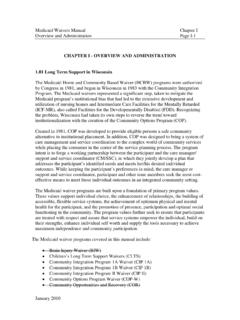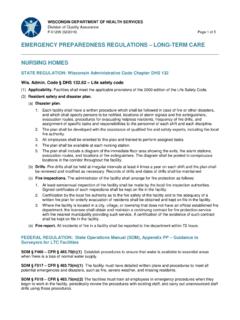Transcription of Chapter 55 Emergency Protective Placements for
1 1 P-00445 (10/2015) Chapter 55 Emergency Protective Placements for Persons with Dementia in Crisis Findings from a department of health services Survey In February 2015, the wisconsin department of health services Bureau of Aging and Disability Resources performed a survey of county adult Protective services (APS) units in order to understand how Emergency Protective Placements are used for people with dementia. This report describes the results of the survey and how the department will use the results to identify what is working well and where to focus efforts to improve the dementia-capability of wisconsin s crisis systems. Background: Chapter 55 The primary purpose of Chapter 55 of the wisconsin Statutes, the Protective Service System, is to provide for the long-term care and custody of individuals who are at risk of harm due to a condition that is, or is likely to be, permanent. Chapter 55 provides Protective services and Protective placement, including Emergency Protective placement, for persons with degenerative brain disorders, severe and persistent mental illness, developmental disabilities, and other like incapacities.
2 Persons who are the subject of an Emergency Protective placement proceeding under Chapter 55 are presumed to be incompetent. The Emergency Protective Placement process under Chapter 55 Emergency Protective Placements are a means of intervening in an Emergency situation if it is probable that a person, as a result of an incapacity defined in Chapter 55, is unable to provide for his or her own care or custody. The situation must create a substantial risk of physical harm to the person, or to others, if Protective action is not immediately taken. A person who requires Emergency Protective placement may be taken into custody and transported to a medical facility, or to a facility or home, for the primary purpose of residential care and custody. Such facilities include nursing homes, public medical institutions, centers for the developmentally disabled under the requirements of s. (3), Wis. Stats., foster care services or other home Placements , or to other appropriate facilities.
3 An appropriate facility does not include units for the acutely mentally ill. A person could also remain in a home or facility where he or she currently resides if appropriate services and supports can be provided. An Emergency Protective placement can only be made by a sheriff or police officer, fire fighter, guardian of the individual, or authorized county representative, such as a representative of the county APS unit or crisis system. 2 P-00445 (10/2015) Emergency Protective Placements The person who is the subject of an Emergency Protective placement is entitled to be informed of his or her rights to contact an attorney, to have an attorney provided at public expense if he or she is indigent, and to contact a member of his or her family. This information must be provided both orally and in writing by the provision of the Notice of Rights on Emergency Protective Placement (Form GN-4010). Unless the person is already under guardianship, a Petition for Protective Placement/ Protective services (Form GN-4040) and a Petition for Guardianship Due to Incompetency (Form GN-3100) must be filed with the court along with the Statement of Emergency Protective Placement and the Notice of Rights on Emergency Protective Placement.
4 There is no requirement for a prior court finding of incompetence and need for guardianship to make an Emergency Protective placement. The preliminary hearing to establish that there is probable cause for Protective placement must be held within 72 hours of the time the placement is made, excluding weekends and legal holidays. Upon finding probable cause, the court may order temporary Protective placement for up to 30 days pending final hearing on permanent Protective placement or the court may order Protective services as may be required. The person making the Emergency Protective placement must prepare a Statement of Emergency Protective Placement (Form GN-4000), which includes specific factual information concerning the person s personal observations of the individual and/or reports made to that person by others. The completed form must be filed with the facility director where the individual is placed. The document may be given to the director or left with a staff person or director designee authorized to accept the document on the director s behalf.
5 Additional information about Emergency Protective Placements is found in the textbox below. Adult Protective services In wisconsin , counties are responsible for implementing the Chapter 55 APS system for individuals-at-risk. Chapter 55 requires that e ach county identify a l ead elder-adults-at-risk ( EAAR) agency for a dults age 60 and over a nd an adults- a t-risk ( AAR) agenc y for a dults ages 18-59 to take pr imary responsibility for r eceiving and responding to alle gations of a buse. Although a c ounty is permitted to put these f unctions in separate a gencies, most combine them in the s ame a gency. Each count y is also required to designate a n APS agenc y responsible f or p roviding pr otective s ervices a nd pr otective Placements to all adults-at- r isk, regardl ess of a ge. The EAAR, AAR, and APS agencies a re of ten referred to as the c ounty APS unit. By law, the designa ted agency must prepare and submit reports as required by the department , or by the courts in cases involving Protective services or Protective placement.
6 Challenges of Responding to Persons with Dementia in Crisis Crises involving dementia present unique challenges for county human services systems and, in particular, for APS. A significant percentage of persons with dementia, experience some type of behavioral change as their disease progresses. Even though only a small number of individuals exhibit self-injurious, aggressive or violent behaviors, when they do occur, these beha viors often require APS to intervene because o f the immediacy and intensity of the need. The difficulty of addressing these behaviors increases whe n the e pisodes are frequent, acute, a nd long-term. Other beha viors such as wandering, sexua l inappropriatene ss, and refusal to bathe or accept care, coupled with a need for constant supervision, can also be c ha lle nging f or care pr oviders and may require APS intervention. These situations may not rise to the level of an Emergency Protective placement.
7 3 P-00445 (10/2015) Responding to challenging beha vi or s by removing a person with dementia from his or her c ur rent living environment to anothe r s etting can further e xacerbate c onfusion and agita tion, cause unnecessary stress, and produce negative health outcomes f or the person. Transfer t rauma is common in persons with dementia. The g oa l is always to respond to the beha vior in a manner that causes the l east disruption to the person. Therefore, Emergency Protective Placements should be an intervention of last resort. In many cases involving a person with dementia in crisis who can no longer remain in his or her current residence, APS is responsible for finding a facility willing to accept the person for stabilization and, if that person cannot return to his or her original residence, locating a facility placement for long-term care. Counties are c ha rged under st ate l aw w ith designa ting an intake facility for e mergency pr otective Placements .
8 However, many counties have been unable to do so because facilities are e ither unwilling or unable to care f or persons w ith dementia who are exhibiting challenging be ha viors. Historically, when persons with dementia in crisis exhibited behaviors deemed to be a threat to their safety, or the safety of others around them, they were commonly admitted to an inpatient mental health unit or facility for treatment to manage the behavior. The legal mechanism for admitting persons to these care facilities was the Chapter 51 Emergency detention process. However, after the wisconsin Supreme Court s decision in Helen E. F., counties have struggled to find facilities other than inpatient mental health units and treatment facilities for persons in crisis who have a dementia diagnosis. The Dementia Care System Redesign is premised on the belief that the difficulty of providing care for persons with dementia who exhibit challenging behaviors is best addressed within the larger context of the dementia care delivery system as a whole.
9 Addressing the needs of persons with dementia by providing for early detection and intervention, quality care services , and crisis stabilization in home, community, and long-term care settings has the potential to significantly reduce the numbers of serious challenging behaviors that result in Emergency Protective Placements and the removal of individuals from their residences. Even if, as a general rule, a facility is willing to accept Emergency Protective Placements , there are still obstacles that preclude acceptance in particular cases involving persons with dementia. Anecdotal reports of obstacles often include aggressive or violent challenging behaviors, need for placement off hours, regulatory requirements for medical evaluations, physician s orders, and communicable disease clearance prior to placement in a facility. The lack of a surrogate decision-maker to authorize treatment during the 72-hour period prior to the probable cause hearing is also a barrier.
10 However, until now, we have lacked reliable information about the extent of these circumstances and their significance. Emergency Protective Placement Survey In February 2015, the wisconsin department of health services Bureau of Aging and Disability Resources (BADR) administered the Survey on Emergency Protective Placement for People with Dementia to county APS units. The survey asked 35 questions about counties Emergency Protective placement practices with a particular focus on the placement of persons with dementia exhibiting challenging behaviors. Counties were instructed to limit their answers to the 72-hour period prior to the probable cause hearing. The goal of the survey was to ascertain best practices for placing individuals with dementia in crisis in an Emergency situation. 4 P-00445 (10/2015) Bureau staff followed up with counties to encourage survey completion. Staff contacted counties who indicated a hospital was one type of facility used for Emergency Protective Placements in order to determine the specific purpose the hospital was used for persons with dementia in crisis.















